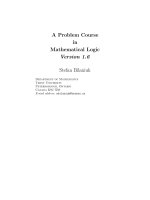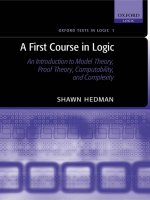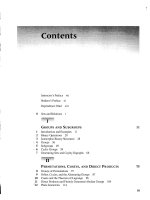A first course in mathematical modeling
Bạn đang xem bản rút gọn của tài liệu. Xem và tải ngay bản đầy đủ của tài liệu tại đây (15.53 MB, 552 trang )
ereface
To facilitate an early initiation of the modeling experience, the first edition of this
text was designed to be taught concurrently or immediately after an introductory
business or engineering calculus course. In the second edition, we added chapters treating discrete dynamical systems, linear programming and numerical search
methods, and an introduction to probabilistic modeling. Additionally, we expanded
our introduction of simulation. In this edition we have included solution methods
to some simple dynamical systems to reveal their long-term behavior. We have
also added basic numerical solution methods to the chapters covering modeling
with differential equations. The text has been reorganized into two parts: Part One,
Discrete Modeling (Chapters 1-8), and Part Two, Continuous Modeling (Chapters
9-12). This organizational structure allows for teaching an entire modeling course
based on Part One and which does not require the calculus. Part Two then addresses continuous models based on optimization and differential equations which
can be presented concurrently with freshman calculus. The text gives students an
opportunity to cover all phases of the mathematical modeling process. The new
CD-ROM accompanying the text contains software, additional modeling scenarios
and projects, and a link to past problems from the Mathematical Contest in Modeling. We thank Sol Garfunkel and the COMAP staff for preparing the CD and
for their support of modeling activities that we refer to under Resource Materials
below.
Goals and Orientation
The course continues to be a bridge between the study of mathematics and the applications of mathematics to various fields. The course affords the student an early
opportunity to see how the pieces of an applied problem fit together. The student
investigates meaningful and practical problems chosen from common experiences
encompassing many academic disciplines, including the mathematical sciences, operations research, engineering, and the management and life sciences.
This text provides an introduction to the entire modeling process. The student
will have occasions to practice the following facets of modeling and enhance their
problem-solving capabilities:
1. Creative and Empirical Model Construction: Given a real-world scenario,
the student learns to identify a problem, make assumptions and collect data, propose
a model, test the assumptions, refine the model as necessary, fit the model to data
if appropriate, and analyze the underlying mathematical structure of the model to
appraise the sensitivity of the conclusions when the assumptions are not precisely
met.
ix
x
Preface
2. Model Analysis: Given a model, the student learns to work backward to
uncover the implicit underlying assumptions, assess critically how well those assumptions fit the scenario at hand, and estimate the sensitivity of the conclusions
when the assumptions are not precisely met.
3. Model Research: The student investigates a specific area to gain a deeper
understanding of some behavior and learns to use what has already been created or
discovered.
Student Background and ~ourse Content
Because our desire is to initiate the modeling experience as early as possible in
the student's program, the only prerequisite for Chapters 9, 10, and 11 is a basic
understanding of single-variable differential and integral calculus. Although some
unfamiliar mathematical ideas are taught as part of the modeling process, the emphasis is on using mathematics already known by the students after completing
high school. This emphasis is especially true in Part One. The modeling course
will then motivate students to study the more advanced courses such as linear algebra, differential equations, optimization and linear programming, numerical analysis, probability, and statistics. The power and utility of these subjects are intimated
throughout the text.
Further, the scenarios and problems in the text are not designed for the application of a particular mathematical technique. Instead, they demand thoughtful ingenuity in using fundamental concepts to find reasonable solutions to "open-ended"
problems. Certain mathematical techniques (such as Monte Carlo simulation, curve
fitting, and dimensional analysis) are presented because often they are not formally
covered at the undergraduate level. Instructors should find great flexibility in adapting the text to meet the particular needs of students through the problem assignments and student projects. We have used this material to teach courses to both
undergraduate and graduate students, and even as a basis for faculty seminars.
Organization of the Text
The organization of the text is best understood with the aid of Figure 1. The first
eight chapters constitute Part One and require only precalculus mathematics as a
prerequisite. We begin with the idea of modeling change using simple finite difference equations. This approach is quite intuitive to the student and provides us
with several concrete models to support our discussion of the modeling process in
Chapter 2. There we classify models, analyze the modeling process, and construct
several proportionality models or submodels which are then revisited in the next
two chapters. In Chapter 3 the student is presented with three criteria for fitting a
specific curve-type to a collected data set, with emphasis on the least-squares criterion. Chapter 4 addresses the problem of capturing the trend of a collected set
of data. In this empirical construction process, we begin with fitting simple oneterm models approximating collected data sets and progress to more sophisticated
interpolating models, including polynomial smoothing models and cubic splines.
Preface
xi
Simulation models are discussed in Chapter 5. An empirical model is fit to some
collected data, and then Monte Carlo simulation is used to duplicate the behavior
being investigated. The presentation motivates the eventual study of probability and
statistics.
Chapter 6 provides an introduction to probabilistic modeling. The topics of
Markov processes, reliability, and linear regression are introduced, building on scenarios and analysis presented previously. Chapter 7 addresses the issue of finding
the best-fitting model using the other two criteria presented in Chapter 3. Linear
programming is the method used for finding the "best" model for one of the criteria,
and numerical search techniques can be used for the other. The chapter concludes
with an introduction to numerical search methods including the dichotomous and
golden section methods. Part One ends with Chapter 8, which is devoted to dimensional analysis, a topic of great importance in the physical sciences and engineering.
xii
Preface
Part Two is dedicated to the study of continuous models. Chapter 9 treats
the construction of continuous graphical models and explores the sensitivity of the
models constructed to the assumptions underlying them. In Chapters 10 and 11 we
model dynamic (time varying) scenarios. These chapters build on the discrete analysis presented in Chapter 1 by now considering situations where time is varying
continuously. Chapter 12 is devoted to the study of continuous optimization. Students get the opportunity to solve continuous optimization problems requiring only
the application of elementary calculus and are introduced to constrained optimization problems as well.
Student Projects
Student projects are an essential part of any modeling course. This text includes
projects in creative and empirical model construction, model analysis, and model
research. Thus we recommend a course consisting of a mixture of projects in all
three facets of modeling. These projects are most instructive if they address scenarios that have no unique solution. Some projec;ts should include real data that
students are either given or can readily collect. A combination of individual and
group projects can also be valuable. Individual projects are appropriate in those
parts of the course in which the instructor wishes to emphasize the development
of individual modeling skills. However, the inclusion of a group project early in
the course gives students the exhilaration of a "brainstorming" session. A variety
of projects is suggested in the text, such as constructing models for various scenarios, completing UMApl modules, or researching a model presented as an example
in the text or class. It is valuable for each student to receive a mixture of projects
requiring either model construction, model analysis, or model research for variety
and confidence building throughout the course. Students might also choose to develop a model in a scenario of particular interest, or analyze a model presented in
another course. We recommend five to eight short projects in a typical modeling
course. Detailed suggestions on how student projects can be assigned and used are
included in the Instructor's Manual that accompany this text.
In terms of the number of scenarios covered throughout the course, as well as
the number of homework problems and projects assigned, we have found it better to
pursue a few that are developed carefully and completely. We have provided many
more problems and projects than can reasonably be assigned to allow for a wide
selection covering many different application areas.
The Role of Computation
Although many chapters of the text do not require computing capability,2 computation does play an important role in any realistic modeling course. We have found
1 UMAP modules are developed and distributed through COMAP, Inc., 57 Bedford Street, Suite 210,
Lexington, MA 02173.
2 Chapters 2, 6, and 8-12 do not require computing capability.
Preface
xi ii
a combination of graphing calculators and computers to be advantageous throughout the course. The use of a spreadsheet is beneficial in Chapters 1, 5, and 7, and
the capability for graphical displays of data is enormously useful, even essential,
whenever data is provided. Students will find computers useful, too, in transforming data, least-squares curve fitting, divided difference tables and cubic splines,
programming simulation models, linear programming and numerical search methods, and numerical solutions to differential equations. The CD accompanying this
text provides some basic technology tools that students and instructors can use as a
foundation for modeling with technology. Several FORTRAN executable programs
are provided to execute the methodologies presented in Chapter 4. Also included is
a tutorial on the computer algebra system MAPLE and its use for this text.
Resource Materials
We have found material provided by the Consortium for Mathematics and Its Application (COMAP) to be outstanding and particularly well suited to the course we
propose. Individual modules for the undergraduate classroom, UMAP Modules,
may be used in a variety of ways. First, they may be used as instructional material
to support several lessons. In this mode a student completes the self-study module
by working through its exercises (the detailed solutions provided with the module
can be conveniently removed before it is issued). Another option is to put together
a block of instruction using one or more UMAP modules suggested in the projects
sections of the text. The modules also provide excellent sources for "model research," because they cover a wide variety of applications of mathematics in many
fields. In this mode, a student is given an appropriate module to research and is
asked to complete and report on the module. Finally, the modules are excellent resources for scenarios for which students can practice model construction. In this
mode the instructor writes a scenario for a student project based on an application
addressed in a particular module and uses the module as background material, perhaps having the student complete the module at a later date. The CD accompanying
the text contains most of the UMAPS referenced throughout. Information on the
availability of newly developed interdisciplinary projects can be obtained by writing COMAP at the address given previously, calling COMAP at 1-800-772-6627,
or electronically:
A great source of student-group projects are the Mathematical Contest in
Modeling (MCM) and the Interdisciplinary Mathematical Contest in Modeling
(IMCM). These projects can be taken from the link provided on the CD and tailored
by the instructor to meet specific goals for their class. These are also good resources
to prepare teams to compete in the MCM and IMCM contests currently sponsored
by the National Security Agency (NSA) and COMAP. The contest is sponsored
by COMAP with funding support from the National Security Agency, the Society
of Industrial and Applied Mathematics, the Institute for Operations Research and
the Management Sciences, and the Mathematical Association of America. Additional information concerning the contest can be obtained by contacting COMAP,
or visiting their website at www.comap.com.
xiv
Preface
Acknowledgments
It is always a pleasure to acknowledge individuals who have played a role in the
development of a book. We are particularly grateful to B.G. (retired) Jack M. Pollin
and Dr. Carroll Wilde for stimulating our interest in teaching modeling and for
support and guidance in our careers. We're indebted to many colleagues for reading
the first edition manuscript and suggesting modifications and problems: Rickey
Kolb, John Kenelly, Robert Schmidt, Stan Leja, Bard Mansager, and especially
Steve Maddox and Jim McNulty.
We are indebted to a number of individuals who authored or co-authored
UMAP materials that support the text: ·David Cameron, Brindell Horelick, Michael
Jaye, Sinan Koont, Stan Leja, Michael Wells, and Carroll Wilde. In addition, we
thank Solomon Garfunkel and the entire COMAP staff for their cooperation on this
project, especially Roland Cheyney for his help with the production of the CD that
accompanies the text. We also thank Tom O'Neil and his students for their contributions to the CD and Tom's helpful suggestions in support of modeling activities.
The production of any mathematics text is a complex process and we have
been especially fortunate in having a superb and creative production staff at
Brooks/Cole. In particular, we express our thanks to Craig Barth, our editor for
the first edition, Gary Ostedt, the second edition, and Gary Ostedt and Bob Pirtle, our editors for this edition. For this edition we are especially grateful to Tom
Ziolkowski, our marketing manager; Tom Novack, our production editor; Merrill
Peterson and Matrix Productions for production service; and Amy Moellering for
her superb copyediting and typesetting. We are especially grateful to Wendy Fox
for providing her drawing of the Cadet Chapel at West Point for the dedication
page.
Finally, we are grateful to our wives-Judi Giordano, Gale Weir, and Wendy
Fox-for their inspiration and support.
Frank R. Giordano
Maurice D. Weir
William P. Fox
Introduction
To help us better understand our world, we often describe a particular phenomenon
mathematically (by means of a function or an equation, for instance). Such a mathematical model is an idealization of the real-world phenomenon and never a completely accurate representation. Although any model has its limitations, a good one
can provide valuable results and conclusions. In this chapter we direct our attention
to modeling change.
Mathematical Models
In modeling our world, we are often interested in predicting the value of a variable
at some time in the future. Perhaps it is a population, a real estate value, or the
number of people with a communicative disease. Often a mathematical model can
help us understand a behavior better or aid us in planning for the future. Let's
think of a mathematical model as a mathematical construct designed to study a
particular real-world system or behavior of interest. The model allows us to reach
mathematical conclusions about the behavior, as illustrated in Figure 1.I. These
conclusions can be interpreted to help a decision maker plan for the future.
Simplification
Most models simplify reality. Generally, models can only approximate real-world
behavior. One very powerful simplifying relationship is proportionality.
Discrete Versus Continuous Change
When constructing models involving change, an important distinction is that some
change takes place in discrete time intervals (such as the depositing of interest in
an account); in other cases, the change happens continuously (such as the change
in the temperature of a cold can of soda on a warm day). Difference equations
represent change in the case of discrete time intervals. Later we will see the relationship between discrete change and continuous change (for which calculus was
developed). For now, in the several models that follow, we approximate a continuous change by examining data taken at discrete time intervals. Approximating a
continuous change by difference equations is an example of model simplification.
EXAMPLE 1
Growth of a Yeast Culture
The data in Figure 1.7 was collected from an experiment measuring the growth of
a yeast culture. The graph represents the assumption that the change in population
is proportional to the current size of the population. That is, /lPn = (Pn+ 1 - Pn) =
kpn, where Pn represents the size of the population biomass after n hours, and k is
a positive constant. The value of k depends on the time measurement.









